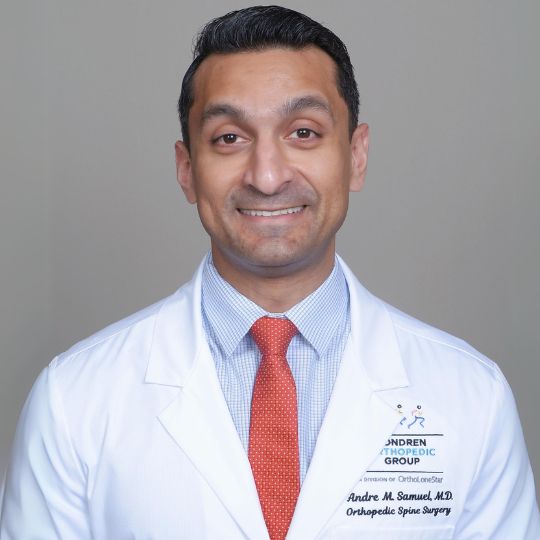Spinal Breakdown Specialist
If you are experiencing pain long after your spinal fusion surgery, you may have spinal breakdown, also known as adjacent segment degeneration. Don’t let your symptoms go untreated. Dr. Andre Samuel, an orthopedic spine specialist, treats patients in the Clear Lake, Houston, and Sugar Land, TX area with this condition. Contact Dr. Samuel’s team today for a thorough evaluation and accurate diagnosis.

What is adjacent segment degeneration?
Adjacent segment degeneration is a type of spinal breakdown that happens when the bones next to a surgically fused area start wearing out. This is common in people who have undergone spinal fusion surgery – joining two or more vertebrae. Since the surgery limits movement in the fused area, the nearby segments have to work harder, which puts extra stress on them. This can lead to pain and other uncomfortable symptoms. Doctor Andre M. Samuel, orthopedic spine specialist, treats patients in the Clear Lake, Houston, Sugar Land, TX area suffering from adjacent segment degeneration.

Who is at risk for adjacent segment degeneration?
Adjacent segment degeneration is most commonly seen in the cervical spine (neck) and lower back (lumbar spine). It’s not as prevalent in the thoracic or chest region, since our ribs tend to keep our middle section immobilized. Patients most at risk for adjacent segment degeneration are those who’ve had spinal fusion surgery. However, it can also be seen in those with pre-existing spinal conditions or people who engage in high-impact activities, like heavy lifting. If you’re overweight, the added stress on your spine increases the chances of a spinal breakdown, including ASD. Smoking can also impair spinal health and healing, making smokers more susceptible to the condition as well.
What are the first signs or symptoms of adjacent segment degeneration?
Spinal breakdowns, such as adjacent segment degeneration typically occur within the first five to ten years following fusion surgery, however, it can take longer for patients to notice anything is wrong. The timing and severity of symptoms can vary from patient to patient depending on the location of a past spinal fusion. Common symptoms include:
- Pain in the back or neck
- Radiating nerve pain, numbness, or weakness in the arms and legs
- Stiffness and reduced range of motion in the spine
While it is not always possible to prevent adjacent segment degeneration, certain measures can help manage and potentially delay its onset such as regular exercise, a healthy lifestyle, and proper posture to reduce stress on the spine. Understanding the risk factors and getting an early diagnosis is also key to treating the condition effectively and reducing further spinal breakdown. It is also important to consult with an experienced doctor like Dr. Samuel to make the proper diagnosis.
How is adjacent segment degeneration diagnosed?
Dr. Samuel takes a full medical history and performs a comprehensive physical exam on each patient. If he suspects Adjacent Segment Degeneration, he may order a combination of imaging studies, including X-rays, MRI, or a CT scan. These tools help Dr. Samuel visualize the extent of any spinal breakdown in the segments adjacent to prior fusion surgery.
What is the treatment for adjacent segment degeneration?
Conservative treatments are typically the first line of defense to ease the symptoms of Adjacent Segment Degeneration. They include:
- Physical Therapy – To improve flexibility and strengthen muscles around the spine.
- Medications – Over-the-counter pain relievers and prescription muscle relaxants.
- Steroid Injections – To help reduce inflammation and ease pain.
If conservative treatments fail to provide relief or if the condition worsens, Dr. Samuel may recommend additional surgery. This may include extending the fusion to include the additional spinal breakdown or other procedures to relieve pressure on the nerves including an artificial disc replacement and minimally invasive laminectomy. Dr. Samuel and his team discuss the pros and cons of each surgical option with their patients, allowing them to make a well-informed decision.


